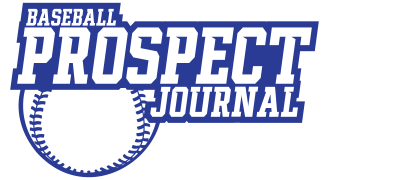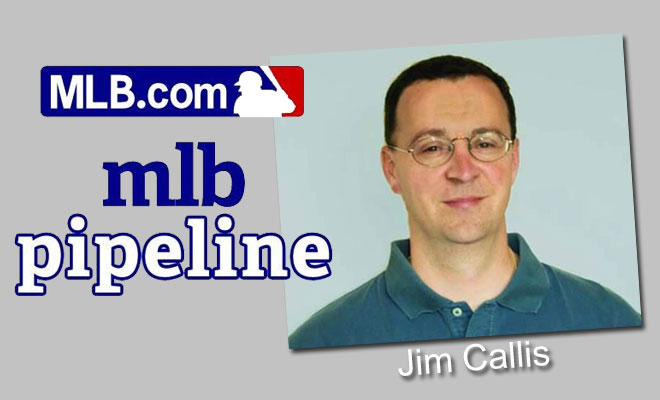With the college baseball season underway and professional players in the midst of spring training games, there’s no one better to talk to about MLB draft and baseball prospects than MLB.com’s Jim Callis.
Callis has exceptional knowledge regarding the future stars of the game, as he’s covered the draft and baseball prospects since 1988.
Read my interview with Callis about top draft prospects and the Brewers’ farm system here:
Dan Zielinski: Daniel Espino, a prep right-handed pitcher, has an advanced pitching repertoire. Is he the best prep pitcher in this year’s draft class?
Jim Callis: I think you might get different answers from different people on that. I think Matthew Allan from Florida would probably be the best prep pitcher in this year’s draft based on the early going. Obviously a lot can change in the next three months until the draft, but I think Allan is probably the best pitcher at this point. Espino is probably the hardest thrower and hits triple digits more than anybody else. He has power to his breaking pitches as well. I am sure teams that are big into pure velo would have him ahead, but I think the consensus would have Matthew Allan.
DZ: People talk about Espino’s projection. Does that really matter with how advanced his pitches already are?
JC: Projection is nice, but I think at the same time, I don’t think you really have to project on Espino’s stuff because it’s pretty good right now. I don’t need him to develop more velocity to buy into his fastball, and I don’t need him to have more power with his breaking pitches to think they are viable. I think if there’s a knock on him, his arm action is a little bit long, which effects his control and command. I don’t think the projection matters as much when you have the present stuff, and he’s got present stuff.
DZ: I’ve heard Duke left-hander Graeme Stinson’s velocity has been down into the high-80s in his last few starts, is that a cause for concern?
JC: Cause for concern might be a little strong this early in the season because he has another three months to show what he can do, but we are talking about a guy coming into the year that was our top-ranked four-year college pitcher on our preseason list. He was a reliever last year and there were questions on how his stuff would translate to the starting rotation. It hasn’t translated as well yet. Now, he’s pitched well and been pretty unhittable, but coming out of the bullpen, he was 91-96 mph with sink and flashed plus-plus sliders too. You are going to want to see that stuff on a consistent basis.
DZ: What does junior college right-handed pitcher Carter Stewart, who the Braves drafted eighth overall last year, have to do to be a top-10 pick again this year?
JC: I think the big thing is health. He had the wrist injury late in the spring and wounded up leading to the Braves passing on him and him not signing. I think he’s had some good outings. If he comes back and does what he did last year where he had the best curveball in the draft and he sat 92-94 mph and touched 97 a lot, then he’s going to go pretty good. He could still be the top pitcher taken when all is said and done, if he goes out and shows the wrist isn’t bothering him. Teams will spend a lot of time looking at the medical reports on his wrist too this spring.
DZ: There are a lot of college shortstops who are potential first-round picks, but it doesn’t seem like this year’s draft is like the 2015 draft where college shortstops Dansby Swanson and Alex Bregman went in the first two picks.
JC: College bats often get pushed up, and I think especially in this draft where I don’t think the pitching really stands out, especially on the college side, you might see one or two of the shortstop jump into the first 10 picks.
With Bryson Stott, Braden Shewmake, Will Holland, Will Wilson, Logan Davidson, who’s off to a slow start, Josh Smith and Greg Jones, I think you are looking at more guys who will go around 20th, instead of like you said, in the early picks of the draft. It’s more depth than that can’t miss, slam dunk shortstops that you’d take at the top of the draft with the college shortstops. While they are plentiful, you’re exactly right, they’ll go more in the middle of the first round.
Josh Smith, the shortstop at LSU, was a guy who didn’t rank in our preseason list but was on my radar in the half of the country that I do the rankings for. I think he’s really helped himself. There’s a lot of college shortstops, and I think Josh Smith has thrusted himself into where he might rank ahead of some guys who were in our preseason top 50.
DZ: Now for some Brewers prospects. Second baseman Keston Hiura has always hit regardless of the level. However, one concern with scouts has always been his defense. With the way he’s hit so far in his pro career, are scouts starting to worry less and less about his defense?
JC: I saw him in the Arizona Fall League, and scouts still had those concerns. He projects, depending on how much you like him, either as an adequate or average defender at second base. The bat is so good and has been as advertised while his defense has been just OK, but that’s what people thought. I don’t think it’s really that big of a concern. I think the interesting thing will be where he falls on the hit versus power spectrum because in the Fall League it seemed like he was more aggressive and trying to hit for power as opposed to average. Although in the championship game in the ninth inning when they needed a hit to tie it, he shortened up his swing and punched a base hit through the middle.
He strikes me as a guy who can do whatever he wants at the plate. If he wants to be a batting champion, I think he’s gifted enough that he has a chance to do that, and if he wants to sacrifice some average and hit 25 or 30 home runs, I think he’s good enough to do that. It’s going to be fun to watch. I know they signed Mike Moustakas and have Travis Shaw and they are going to bounce those guys between second and third, but with them expecting to contend, you are going to play your best guys, and there may come a time this summer where he’s their best second-base option.
DZ: Talking about a guy who’s maybe sacrificed some average for power, at least statistically, is outfielder Corey Ray. He was a guy coming out of Louisville that was a big-time player, but in his pro career, he’s struck out a lot while hitting for more power than average. Do you think that’s the kind of player he’s going to be – more of a power, low-average guy who’s solid defensively?
JC: I think so because we’ve seen him for three years now. I think if Corey wanted to be more of a .270 and 20 home run guy, instead of a .240 and 25-30 home run guy, I think he could be. He’s more of a 30-30 guy that can play center field. He is going to strikeout, but the nice thing is, he’s starting to draw walks.
I thought they pushed him a little aggressively his first year, as getting him to Class A-Advanced his first pro summer was a lot to ask. Then he had the minor injury, and I think he tried to make up for the lost time and do too much. Frankly, he didn’t look great in the Arizona Fall League two years ago and looked like he was still trying to figure it out. Last year, he started to figure some things out. I think what we’ve seen from him is the type of hitter that he’s on track to becoming where it’s definitely power over average.
DZ: The Brewers have a lot of young pitchers with Corbin Burnes, Brandon Woodruff, Freddy Peralta and Zack Brown. Is at least one of those guys either a No. 1 or No. 2 starter in the big leagues or are all of them more middle-of-the-rotation arms?
JC: They are probably more middle-of-the-rotation arms. I will say, given how successful he was in the minors, maybe Corbin Burnes has a chance to be a No. 2. He had a great year when he started two years ago, and then last year, the Brewers had the bullpen need at the big-league level and he performed there. It’s not unbelievable frontline or No. 1 stuff, but he does have good stuff. He knows how to use it. He’s succeeded in multiple roles. I think maybe he will continue to do that. I never understood why he lasted until the fourth round of the draft, but the Brewers aren’t complaining.
Dan Zielinski III has covered the MLB draft for four years. He’s interviewed 133 of the top draft prospects in that period, including three No. 1 overall picks. Multiple publications, including Baseball America, USA Today and The Arizona Republic, have quoted his work, while he’s appeared on radio stations as a “MLB draft expert.” Follow him on Twitter @DanZielinski3.



[…] consistency throughout their careers, and Jimmy Nelson is a wildcard after missing all last season. Brandon Woodruff, Corbin Burnes, Freddy Peralta and Zack Brown are all young arms without a proven track record at the major-league […]
[…] Baseball Prospect Journal chats with MLB.com prospect guru Jim Callis. […]
[…] Baseball Prospect Journal chats with MLB.com prospect guru Jim Callis. […]
[…] Baseball Prospect Journal chats with MLB.com prospect guru Jim Callis. […]
[…] Baseball Prospect Journal chats with MLB.com prospect guru Jim Callis. […]